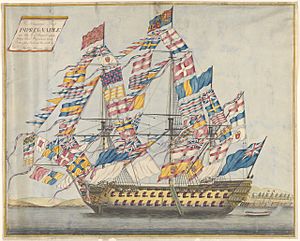HMS Impregnable (1786) facts for kids

HMS Impregnable on 17 August 1789, when King George III visited the ship
|
|
Quick facts for kids History |
|
|---|---|
| Name | HMS Impregnable |
| Ordered | 13 September 1780 |
| Builder | Deptford Dockyard |
| Laid down | October 1781 |
| Launched | 15 April 1786 |
| Fate | Wrecked 18 October 1799 |
| Notes |
|
| General characteristics | |
| Class and type | London-class ship of the line |
| Tons burthen | 188647⁄94 (bm) |
| Length | 177 ft 6 in (54.10 m) (gundeck) |
| Beam | 49 ft (15 m) |
| Depth of hold | 21 ft (6.4 m) |
| Propulsion | Sails |
| Sail plan | Full-rigged ship |
| Armament |
|
HMS Impregnable was a powerful warship of the Royal Navy. It was a 'ship of the line' with 98 guns, meaning it was a large and important vessel. It was built at Deptford Dockyard and launched on April 15, 1786. Sadly, the ship was wrecked in 1799 near Spithead.
Contents
Life of a Warship: HMS Impregnable's Service
HMS Impregnable started active service in October 1787. Its first captain was Thomas Pringle.
Early Years and Important Roles
The next year, Captain Thomas Byard took command. The Impregnable became the 'flagship' for Vice-Admiral Thomas Graves. This meant it was the ship where the admiral lived and directed his fleet. It also served as a 'guardship' at Plymouth Dockyard, protecting the harbor.
In May 1790, the ship was 'refitted' at Plymouth. This means it was repaired and prepared for duty with the Channel Fleet. This was because of a disagreement with Spain, known as the Spanish Armament. From August, Impregnable was the flagship for Rear-Admiral Sir Richard Bickerton.
The ship continued its service during another disagreement, the Russian Armament, the next year. Its admiral then was Rear-Admiral Phillips Cosby. After this, the ship was 'paid off' in September, meaning it was taken out of active service.
Fighting in the French Revolutionary Wars
Impregnable was brought back into service in September 1793. This was because the French Revolutionary Wars had begun. Captain George Blagdon Westcott was in charge, and it was the flagship for Rear-Admiral Benjamin Caldwell.
Under Caldwell and Westcott, the ship bravely fought in a major battle called the Glorious First of June in 1794. This was a big naval battle between the British and French fleets.
After this, the ship had several different captains. Captain Charles Cotton took over in October 1794. Then, Captain Andrew Mitchell commanded in 1795. Finally, Captain John Thompson took charge in July of that year.
In August 1796, Impregnable was 'paid off' again. But it was brought back into service one last time in June 1799, under Captain Jonathan Faulknor.
The Ship's Final Journey and Wreck
Impregnable was lost near Chichester on October 18, 1799. The ship had been guiding a group of 12 merchant ships from Lisbon to the Isle of Wight. The ship's master, Michael Jenkins, was eager to reach Spithead that night.
Running Aground
Because of this hurry, the ship ended up hitting the Chichester Shoals, which are shallow areas in the water. Captain Faulknor ordered the crew to cut away the masts to make the ship lighter. They also tried to anchor for the night.
When morning came, the crew found that the ship had moved even further over the shoals. It was now stuck in mud flats near the entrance to Langstone Harbour. The next day, they discovered the ship was 'bilged'. This means its bottom was badly damaged and water was coming in.
Rescue and Aftermath
Captain Faulknor realized the ship could not be saved. A group of smaller boats from Langstone and Spithead dockyards came to help. They successfully rescued the crew, the ship's guns, and other valuable items.
The Admiralty, which was in charge of the Royal Navy, later sold the remains of Impregnable to a merchant in Portsmouth. A special naval court meeting, called a 'court martial', was held on October 30, 1799. Master Jenkins was dismissed from his service because of the incident.


